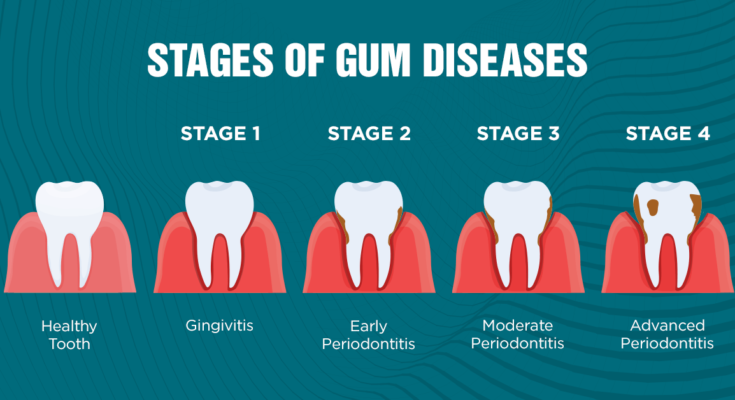Gingivitis Treatment: Gingivitis, a common and mild form of gum disease (periodontal disease), causes irritation, redness, and swelling (inflammation) of your gingiva, the part of your gum around the base of your teeth.
It’s important to take gingivitis seriously and treat it promptly. Gingivitis can lead to much more serious gum disease called periodontitis and tooth loss if not managed effectively.
What is Gingivitis?
Gingivitis is a common and mild form of gum disease (periodontal disease) that causes irritation, redness, and swelling (inflammation) of your gingiva, the part of your gum around the base of your teeth. It’s important to take gingivitis seriously and treat it promptly. Gingivitis can lead to much more severe gum disease called periodontitis and tooth loss if not managed effectively.
Causes and Risk Factors Contributing to Gingivitis
The primary cause of gingivitis is poor oral hygiene that encourages plaque to form on teeth, leading to inflammation of the surrounding gum tissues. Here are key risk factors that can increase your likelihood of developing gingivitis:
- Poor brushing and flossing habits that do not effectively remove plaque and food particles from the gums and teeth.
- Smoking or chewing tobacco, which harms the gum tissues and can hinder the healing process.
- Older age, as gums tend to recede and weaken with age.
- Dry mouth, which can be caused by medications or certain conditions, reducing the mouth’s ability to wash away food particles and plaque.
- Nutritional deficiencies, such as low vitamin C intake, which can impair gum health and healing.
- Existing medical conditions such as diabetes, which can affect the body’s ability to use blood sugar and increase the risk of infections, including gum disease.
- Hormonal changes in women, which can make gums more sensitive and more susceptible to gingivitis.
Importance of Understanding Gingivitis for Effective Treatment
Understanding gingivitis is crucial for effective treatment and prevention. Early detection and treatment can prevent gingivitis from developing into more severe periodontitis or causing tooth loss. Recognizing the causes and risk factors can also lead to proactive measures in oral hygiene, dietary choices, and lifestyle changes that enhance oral health. Regular dental check-ups, proper brushing and flossing techniques, and quitting tobacco use are essential steps in preventing and managing gingivitis. Knowledge about gingivitis empowers individuals to maintain a healthy mouth and a strong, vibrant smile.
Symptoms of Gingivitis
It’s important to recognize the early and progressive symptoms of gingivitis not only to treat it promptly but also to prevent its escalation into more serious dental issues. Here’s a closer look at the symptoms of gingivitis and how they can affect your daily life and long-term dental health.
Early Symptoms of Gingivitis
- Red or Swollen Gums: One of the first signs of gingivitis is gum redness or puffiness. Healthy gums are typically a pale pink and fit snugly around teeth.
- Bleeding Gums: Gums bleeding during brushing or flossing is a notable early symptom. This bleeding is usually painless but consistent.
- Bad Breath: Persistent bad breath or a bad taste in the mouth can also indicate gingivitis, often due to the bacteria that accumulate in plaque.
Recognizing these symptoms early is crucial for effective treatment, as gingivitis is reversible with proper dental care and hygiene.
Progressive Symptoms of Gingivitis
If left untreated, gingivitis can progress, leading to more severe symptoms, such as:
- Receding Gums: Gums may begin to pull away from the teeth, exposing more of the tooth or the tooth’s root.
- Tender Gums: As the condition worsens, gums may become painful to the touch.
- Sensitive Teeth: Increased sensitivity to hot, cold, or sweet foods may occur due to the receding gums exposing the more sensitive parts of the tooth.
These symptoms can significantly impact daily life, making eating and oral care uncomfortable or even painful.
Impact on Daily Life and Long-Term Dental Health
Daily Life: The discomfort and pain from gingivitis can make routine activities, such as eating, drinking, and brushing teeth, challenging and unpleasant. The persistent bad breath associated with gingivitis can also affect social interactions and self-esteem.
Long-Term Dental Health: Without treatment, gingivitis can advance to periodontitis, a more severe form of gum disease that can lead to tooth loss and has been linked to other health issues, including heart disease and diabetes. Early intervention and maintaining good oral hygiene are key to preventing these serious outcomes.
However, understanding the symptoms of gingivitis and seeking prompt dental care can not only improve your daily quality of life but also prevent long-term health complications. Regular dental check-ups, proper brushing and flossing, and professional cleanings are essential steps in protecting your oral health.
Diagnosing Gingivitis
Understanding the process for diagnosing gingivitis, the tools used, and the importance of early detection can help prevent its progression into more severe conditions.
Overview of Professional Dental Assessments for Gingivitis
Dental professionals typically begin with a thorough examination of your gums during routine check-ups to assess for signs of gingivitis. They look for redness, swelling, and bleeding of the gums, which are early indicators of the condition. The assessment includes reviewing your dental and medical history to identify any contributing factors such as smoking or diabetes that may exacerbate gum disease.
Tools and Tests Used in the Diagnosis of Gingivitis
The diagnosis of gingivitis involves several tools and tests to ensure a comprehensive evaluation:
- Dental Exams: A detailed inspection of your gums, teeth, and mouth to check for the common signs of gingivitis.
- Periodontal Probing: This tool measures the depth of the space between your teeth and gums. Shallow spaces are normal, whereas deeper spaces may indicate gum disease.
- X-rays: Dental X-rays can be crucial for determining the health of your bones beneath the gums. They help detect any bone loss around your teeth, which is a sign of advanced gum disease.
- Gingival Index: Some dentists might use this scoring system to quantify the severity of your gingivitis based on the level of inflammation and bleeding.
Importance of Early Diagnosis in Preventing Further Complications
Early diagnosis of gingivitis is essential for preventing the progression to periodontitis, a more severe form of gum disease that can lead to tooth loss and other serious health complications. By catching gingivitis early, treatments can be more effective, typically involving less invasive methods such as professional cleaning and improved daily oral hygiene. Regular dental visits are crucial as they allow for early detection and management of symptoms before they evolve into more significant health issues.
However, regular and thorough dental assessments are vital for diagnosing gingivitis early. By utilizing appropriate diagnostic tools and understanding the importance of early detection, dental professionals can effectively manage and treat gingivitis, helping to maintain both oral and overall health.
Professional Treatments for Gingivitis
Fortunately, there are several professional treatments available that effectively manage and cure gingivitis. Understanding these methods can help individuals seeking relief from gum inflammation and prevent further complications.
List of Professional Methods of Treatments for Gingivitis
- Scaling and Root Planing: This deep-cleaning, non-surgical procedure involves removing plaque and tartar from above and below the gum line. Root planing smooths rough areas on the tooth root where germs gather, helping to remove bacteria that contribute to the disease.
- Dental Cleaning: Regular professional cleanings can prevent gingivitis by removing plaque and tartar that daily brushing and flossing might miss.
- Laser Treatment: This modern technique uses laser beams to remove inflamed gum tissue and kill harmful bacteria, often resulting in less pain and faster healing than other treatments.
Role of Antibiotics and Other Medicinal Treatments
Medicinal treatments play a crucial role in controlling and eliminating gingivitis, especially when it’s caused by bacterial infection. Antibiotics can be administered in various forms:
- Topical Antibiotics: These include antibiotic mouthwash or gels applied directly to the gum pockets after deep cleaning.
- Oral Antibiotics: These can help eliminate infection-causing bacteria that remain in the mouth after cleaning procedures.
Advanced Treatments for Severe Cases
For more severe cases of gingivitis, which might evolve into periodontitis, more intensive treatments are necessary:
- Flap Surgery (Pocket Reduction Surgery): In this procedure, gums are lifted back to remove tartar deposits in deep pockets. The gums are then sutured back in place so that the tissue fits snugly around the tooth again. This method reduces the size of the space between the gum and tooth, decreasing the areas where harmful bacteria can grow.
- Bone and Tissue Grafts: These procedures are used to regenerate any bone or gum tissue lost to periodontitis. Bone grafts involve placing natural or synthetic bone in the area of bone loss, which can help promote bone regrowth, while tissue grafts involve grafting new gum tissue to cover areas where severe gum recession has occurred.
Patients experiencing signs of gingivitis should consult with their dentist to determine the best treatment plan tailored to their needs. Regular dental visits and maintaining good oral hygiene are essential in preventing gingivitis and ensuring a healthy mouth.
Home Remedies and Lifestyle Changes for Managing Gingivitis
Gingivitis, a common form of gum disease, can often be managed effectively at home with simple remedies and lifestyle modifications. Here’s how you can keep your gums healthy and prevent the progression of gingivitis.
Effective Home Remedies for Mild Gingivitis
- Salt Water Rinse: Rinsing your mouth with a saltwater solution can help reduce bacteria and soothe inflamed gums. Dissolve a half teaspoon of salt in a cup of warm water and swish it around your mouth for 30 seconds before spitting it out.
- Baking Soda Paste: Mix baking soda with a little water to create a paste and use it to brush your gums gently. Baking soda neutralizes acids in the mouth, reducing the risk of gum disease and improving overall oral health.
- Tea Tree Oil: Known for its antibacterial properties, tea tree oil can help fight bacterial infection in the gums. Add a drop of tea tree oil to your toothpaste or look for toothpaste that contains tea tree oil.
- Aloe Vera: Apply aloe vera gel to your gums to reduce inflammation and soothe sore tissues. Aloe vera is gentle and has natural antibacterial properties, making it an excellent remedy for gingivitis.
Lifestyle Modifications to Prevent and Treat Gingivitis
- Improved Dental Hygiene: Brushing twice a day, flossing daily, and using an antiseptic mouthwash are crucial steps in preventing gingivitis. Invest in a good quality toothbrush and replace it every three months.
- Diet Changes: Incorporate foods rich in vitamin C and calcium, which can strengthen gums and teeth. Avoid sugary snacks and drinks, as sugar encourages bacterial growth and plaque formation.
- Quit Smoking: Smoking is a significant risk factor for gum disease. Quitting smoking can dramatically reduce your chances of developing gingivitis and other oral health problems.
Importance of Regular Dental Check-ups and Cleanings
Regular visits to the dentist are essential for maintaining oral health and preventing gingivitis. Professional cleanings can remove plaque and tartar that brushing and flossing can’t reach. Your dentist can also spot early signs of gum disease and recommend treatments to prevent its progression. Aim for a dental check-up and cleaning every six months, or more frequently if recommended by your dentist.
By adopting these home remedies and lifestyle changes, you can effectively manage gingivitis and maintain a healthy, vibrant smile.
Complications of Untreated Gingivitis
Gingivitis, a common form of gum disease, can lead to serious dental and health complications if left untreated. Recognizing the risks associated with untreated gingivitis can prompt timely intervention and prevent long-term issues.
Dental Complications of Untreated Gingivitis
- Periodontitis: Untreated gingivitis can progress to periodontitis, a more severe gum disease that damages the soft tissue and destroys the bone that supports your teeth, potentially leading to tooth loss.
- Tooth Loss: As the gums become more inflamed and the bone deteriorates, teeth may become loose and eventually fall out.
- Receding Gums: Chronic inflammation can cause the gums to recede, exposing the roots of the teeth and increasing sensitivity and the risk of decay.
Health Complications Beyond the Mouth
Untreated gingivitis may also have implications beyond oral health:
- Heart Disease: Research suggests a link between oral inflammation caused by gingivitis and heart disease. The bacteria from inflamed gums can enter the bloodstream, potentially leading to arterial plaque and heart disease.
- Diabetes: For those with diabetes, gingivitis can complicate blood sugar control. Conversely, poorly controlled diabetes can increase the risk of developing infections, including gum disease.
- Respiratory Issues: Bacteria from the mouth can be inhaled into the lungs, potentially leading to respiratory diseases like pneumonia, especially in individuals with weakened immune systems.
Addressing gingivitis promptly not only preserves dental health but may also mitigate the risk of these serious systemic health issues. Regular dental check-ups and maintaining good oral hygiene are essential steps in preventing gingivitis and its associated complications.
Preventive Measures and Ongoing Management for Healthy Gums
Preventing gingivitis and maintaining the health of your gums and teeth requires consistent care and attention. Here are effective strategies to prevent gingivitis through good oral hygiene and lifestyle choices, along with tips for maintaining gum and teeth health after treatment. Understanding the importance of ongoing management can help prevent the recurrence of gum disease.
Strategies for Preventing Gingivitis
- Regular Brushing and Flossing: Brush your teeth at least twice a day using fluoride toothpaste. Floss daily to remove plaque from areas your toothbrush can’t reach.
- Use of Antimicrobial Mouthwash: Incorporate an antimicrobial mouthwash into your daily routine to reduce plaque and prevent gingivitis.
- Healthy Diet: Eat a balanced diet and limit sugary snacks and drinks, which can promote plaque formation.
- Quit Smoking: Smoking is a significant risk factor for gum disease. Quitting smoking can improve your overall oral health.
- Regular Dental Checkups: Visit your dentist at least twice a year for professional cleanings and to check for any signs of gum disease.
Tips for Maintaining Healthy Gums and Teeth After Treatment
- Follow Your Dentist’s Instructions: Post-treatment care is crucial. Follow any specific instructions your dentist gives you to aid recovery.
- Maintain Oral Hygiene: Continue with diligent brushing and flossing habits to keep plaque at bay.
- Monitor Your Gums: Keep an eye on your gums for signs of redness or bleeding, and report these to your dentist immediately.
- Use Therapeutic Mouthwash: Depending on your dentist’s advice, using a therapeutic mouthwash can help maintain oral health.
Importance of Ongoing Management to Prevent Recurrence
Ongoing management of gum health is essential to prevent the recurrence of gingivitis. Regular visits to the dentist for check-ups and professional cleanings are vital. These visits allow your dentist to monitor your gums and teeth, making early intervention possible if symptoms reappear. Staying committed to a robust oral hygiene regimen is the best way to keep your gums and teeth healthy in the long term.
By adopting these preventive measures and committing to ongoing management, you can ensure the long-term health of your gums and teeth, minimizing the risk of gingivitis and other oral health issues.
FAQs about Gingivitis Treatment
What is gingivitis?
Gingivitis is a mild form of gum disease characterized by inflammation of the gums. It’s typically caused by poor oral hygiene, which leads to plaque buildup on the teeth.
How can I tell if I have gingivitis?
Common symptoms of gingivitis include red, swollen, or bleeding gums, especially during brushing or flossing. Persistent bad breath or a bad taste in the mouth can also be indicators.
What are the best treatments for gingivitis?
The primary treatment for gingivitis involves thorough cleaning by a dental professional, coupled with improved home care, such as regular brushing and flossing. Depending on the severity, your dentist might also recommend antiseptic mouthwashes.
Can gingivitis be cured?
Yes, with prompt treatment, gingivitis can be reversed. Adhering to a good oral hygiene regimen is crucial to prevent it from recurring.
How long does it take to treat gingivitis?
Improvement can be seen in as little as a few days to weeks after beginning proper oral care and professional treatments. Consistency in oral hygiene practices is essential for lasting results.
Is gingivitis contagious?
Gingivitis itself is not contagious. However, the bacteria causing the inflammation can be transferred through saliva, potentially leading to similar issues in others if oral hygiene is poor.
What can happen if gingivitis is left untreated?
If not treated, gingivitis can progress to periodontitis, a more severe gum disease that can lead to tooth loss and other serious health problems.
Conclusion
In summary, this article has explored the essential aspects of recognizing and addressing gingivitis, a common but manageable gum disease. We discussed its symptoms, such as red, swollen gums and bleeding during brushing, along with effective preventive measures and treatment options. Regular dental hygiene, including proper brushing and flossing, plays a pivotal role in preventing gingivitis.
If you’re experiencing any symptoms of gingivitis, it’s crucial to consult with a dental professional. Early intervention is key to managing this condition effectively and avoiding more serious complications. Remember, taking proactive steps towards dental health not only preserves your gums but also your overall well-being. Don’t hesitate to reach out to your dentist for guidance and treatment to maintain a healthy, vibrant smile.
References
For more detailed information on gingivitis treatment and to validate the claims made in this article, the following reputable sources are highly recommended. These links lead to authoritative articles and research papers that provide deeper insights and additional data.
- American Dental Association (ADA) – Gingivitis and Periodontal Disease
The ADA offers comprehensive guidelines on the prevention and treatment of gingivitis, including recommendations for daily oral care and professional treatments. - Centers for Disease Control and Prevention (CDC) – Oral Health Tips
This resource provides essential tips on maintaining oral health, which can help prevent gingivitis. It includes practical advice on brushing, flossing, and regular dental visits. - National Institute of Dental and Craniofacial Research – Periodontal (Gum) Disease
Explore detailed scientific information on the causes, symptoms, and treatments of periodontal diseases, including gingivitis. This site also covers the latest research in the field. - Mayo Clinic – Gingivitis Treatment and Drugs
The Mayo Clinic provides a well-rounded overview of treatment options for gingivitis, offering both home remedies and professional care advice.
Each of these resources has been selected for its authority and reliability in the field of dental health. They are ideal for patients seeking to understand gingivitis better and for professionals looking for the latest treatment protocols.



